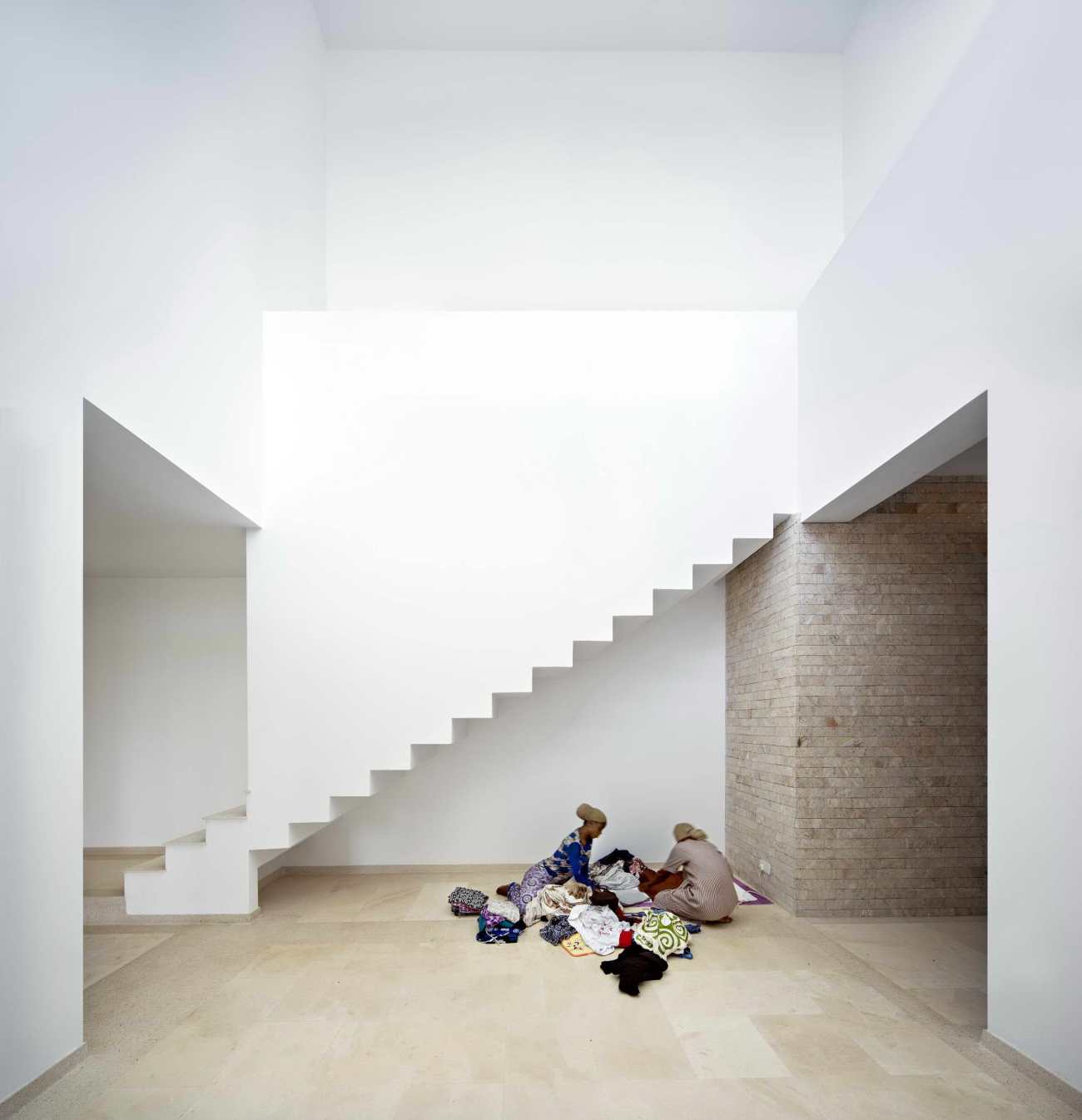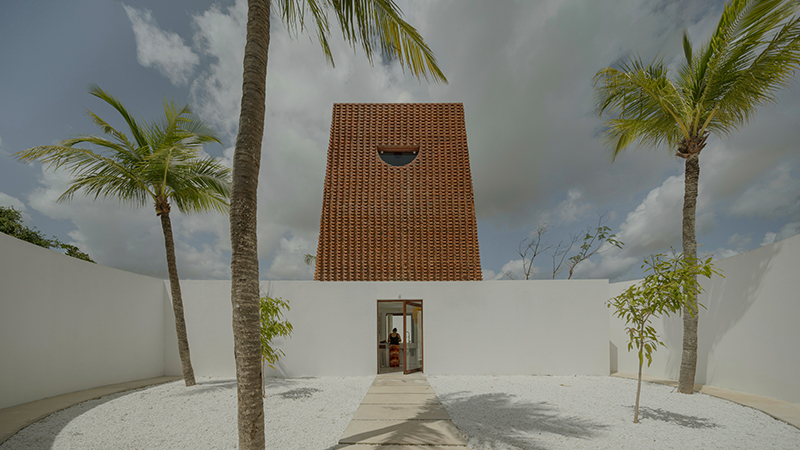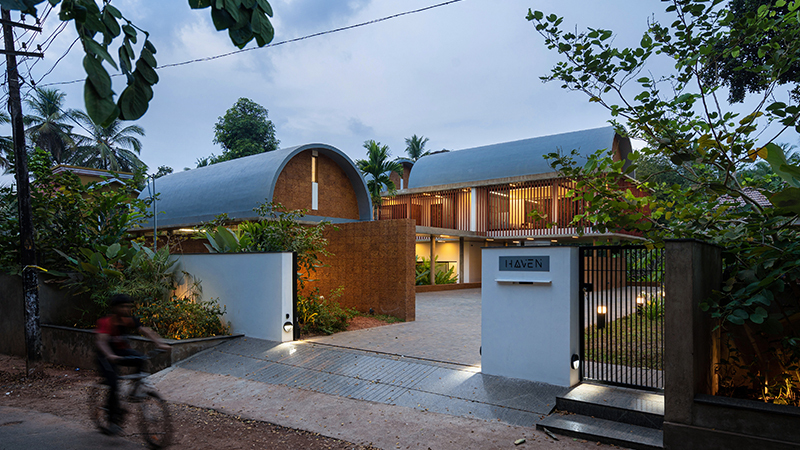| 公司: | Urko Sanchez Architects | 类型: | 建筑 |
|---|---|---|---|
| 地区: | 肯尼亚 | 标签: | 别墅私宅 |
项目概述
该项目由位于肯尼亚蒙巴萨Tudor Creek的14套公寓组成。其特点是采用moucharabiah结构的外壳,它的特点是寻求隐私和优化自然通风和光线。在我们的愿景下,这些公寓受益于户外生活的体验,与自然接触,并将周围的环境融入每个私人住宅。
OVERVIEW
The project consists in 14 apartments in Tudor Creek, Mombasa-Kenya. Characterized by a moucharabiah structural shell, it is distinct with its search for privacy and optimized natural ventilation and light. With our vision, the apartments benefit from the experience of outdoor living, contact with nature and the integration of the surroundings into each private home.
位置背景
蒙巴萨位于肯尼亚的东海岸,是该国的第二大城市。它是一个多元文化和战略中心,以贸易和技术工匠著称,其特点是热带草原气候和小溪横穿的土地。我们的干预区图德(Tudor)位于蒙巴萨岛北部的小河边,这是一个优越的位置。周围有茂盛的植被和宁静的社区,该项目自然地融入了这个环境。我们与客户紧密合作,通过适应土地的自然坡度,使用当地的材料和技术,创造一个对环境影响最小的建筑。
LOCATION / CONTEXT
Located on the east coast of Kenya, Mombasa is the second-largest city in the country. A multicultural and strategic centre known for trading and skilled craftsmen, it is characterized by a savanna tropical climate and a land crossed by creeks. Tudor, our intervention zone, is situated on the creek´s waterfront, which is a privileged location north of Mombasa Island. With lush vegetation all around and a serene neighbourhood, the project naturally fits into this environment. We worked closely with the client to create a building with minimal environmental impact, by adapting to the land’s natural slope, and by using locally available materials and know-how.
要求与设计限制
-最大限度地提高公寓内外的风景,特别是通过露台和阳台的风景;
-环境友好,自然通风的空间:被动冷却。采光良好的空间,这是一个挑战,因为光线必须在没有太阳热量的情况下进入。雨水收集,受水资源匮乏的驱动。太阳能加热水,以节省能源。当地的、长久的材料;
-确保靠近道路的隐私,以及相邻地块的邻居的隐私:一边是公寓楼,另一边是私人住宅,有可能是大型住宅开发。
REQUIREMENTS / SITUATION CONSTRAINTS
-Maximize the scenery from within and outside the apartments, notably via terraces and balconies
-Environmentally friendly:
Naturally aerated spaces: passive cooling. Well-lit spaces, a challenge, as light must come in without the sun heat. Rainwater collection, driven by water scarcity. Solar-heated water for energy saving. Local, long lasting materials
-Ensure privacy regarding the proximity of the road, and that of the neighbours in the adjacent plots: a building of flats on one side, a private house on the other with a risk of major residential development. This was a drive for creating the filtering shell.
▼设计过程 Process diagram
项目
项目是一个以其创新建筑为荣的开发项目,通过从斯瓦希里设计的丰富传统中汲取灵感,显示其对蒙巴萨历史的重视。这个开发项目致力于协调蒙巴萨的过去、现在和未来。项目是一个由14套公寓组成的私密开发项目,所有公寓都能提供令人窒息的溪流全景。我们开发了一个标志性的建筑,具有创新的建筑设计,最高标准的产品装饰,豪华的现代生活方式,以及对自然和当地遗产的尊重。
PROPOSAL
Swahili Gem is a development that prides itself in its innovative architecture, showing its attachment to Mombasa’s history by borrowing inspiration from the rich traditions of Swahili design. This development project is committed to harmonizing Mombasa’s past, present and future. The proposal is an intimate development of 14 apartments, all offering breath-taking panoramic views on the creek. We developed an iconic building, with innovation of architectural designs, highest standards of product finishes, luxurious, contemporary lifestyle, and respect for the natural and local heritage.
该地块的坡度和狭窄的形状引导我们的设计,使建筑的影响最小化。在地块的下部,面向小溪的陡峭落差被三个独特的天井式房屋所过滤,它们一个接一个。在过滤光线的基础上,天井通过面向水面的可渗透的木格子实现通风。他们可以通过横向楼梯到达,这些楼梯向小溪方向下降,经过底部的综合健身房,到达一个无边泳池。与邻居和道路的距离,给建筑带来了良好的影响,使其在风景中存在,但不至于压倒性。这样一来,公寓楼被其保护性的外皮所包裹,面向道路,俯瞰小河,顶部有一个顶楼。
The plot’s slope and its narrow shape guided our design to minimize the building’s impact. The steep drop towards the creek, on the lower part of the plot, was saved with three distinct and unique patio houses, stepped one into the other. On top of filtering light, the patios allow ventilation via permeable wood lattices facing the water. They are accessible via lateral stairs that descend towards the creek, passing by an integrated gym at the bottom, and arriving to an infinity pool. A measured distance from the neighbours and the road give the building a well-weighted impact, for it to be present but not overwhelming in the scenery. This way, the apartments block, enveloped with its protective skin, rises facing the road, overlooking the creek, and topped with a penthouse.
▼剖轴侧图 Building Diagram
环境因素
该项目小心翼翼地保留了现场的红树林和其他树木。此外,自然、被动通风是项目设计的一个指导性主题。在公寓里,交叉通风可以从海里通过遮阳的露台,通过集成的木格子和周围的围护结构,进入室内。在独特的底层住宅中,天井允许双重通风:木格子允许空气从海边通过室内和天井循环;两个叠加的格子允许房屋和假天花板通风,以避免它从顶部露台的阳光中传递热量。此外,植被被整合在天井和阳台上,提供了清新和绿色。在没有足够的污水处理系统连接的情况下,我们整合了一个生物分解器,用于处理用过的水,然后再将其释放到自然中,也就是说,释放到小溪水中。此外,雨水收集为花园的护理提供水源。
ENVIRONMENTAL FEATURES
The development was careful to leave the mangroves and other trees intact on site. In addition, natural, passive ventilation was a guiding theme in the project design. In the apartments, cross ventilation is possible from the sea, through the shaded terraces, to the interiors, via the integrated wooden lattices and through the surrounding envelope. In the distinct bottom houses, the patios allow double ventilation: wood lattices allow air to circulate from the seaside through the interiors and to the patios; two superimposed lattices allow ventilation for both the house and the false ceiling, to avoid it transmitting heat from the sun on the top terraces. Moreover, vegetation is integrated in the patios and on the terraces, offering freshness and greenery. In the absence of sufficient connection to the sewage system, we integrated a bio-digester for treating used waters before releasing them into nature, that is to say, in the creek water. Furthermore, rainwater collection provides water for care for the garden.
▼自然通风分析 Apartment Diagram
结构性立面:现代格栅
我们在研究了不同的传统模式后,设计了格栅的、立面。它的作用是保护与周围环境的隐私,以及为房屋提供我们想要的过滤的自然光。这层立面包裹着公寓楼,留下了它的北面,阳台面向大海,充分利用了令人窒息的风景。此外,由于工程团队的努力,该表皮完全是结构化的。对肯尼亚来说,这种结构性表皮的实现要归功于当地和国际工程师的手工作业,以及现场的钢筋工人,他们通过奉献和细心,在没有任何技术的情况下完成了完美的钢筋弯曲工作。在空间上,这层皮也改变了当地人在窗户上安装钢筋的倾向,本身成为边界和过滤器。有时,外壳是内部房屋空间的直接界限,有时则是阳光和热量的第一个过滤器,由内部手工制作的木格子百叶窗过滤。
STRUCTURAL SKIN: CONTEMPORARY MUCHRABIAH
We designed the mucharabiah skin following a study of different traditional patterns. It serves for the privacy in relation to the surroundings, and for the filtered, natural light we wanted for the houses. This skin wraps itself around the apartments block, leaving its Northern façade free, with balconies facing the sea and taking full advantage of the breath-taking scenery. Moreover, the skin was rendered entirely structural thanks to the engineering team. A novelty to Kenya, such structural skin was possible thanks to local and international engineers working hand by hand, and to the steel workers on-site who managed, by dedication and care, flawless bar bending work without access to any technology. Spatially, this skin also redirects people’s local tendency to put bars on their windows, becoming itself the border and the filter. Sometimes the direct limit of the internal house spaces, the shell is at other times a first filter of sunlight and heat, doubled by internal handcrafted wood-lattice shutters. In this way, light is generous and heat is broken down.
工艺,技术,团队合作
除了白色、石膏饰面外,该项目使用了mtomo饰面,这是一种源于Lamu的珊瑚石覆层技术,由于珊瑚石的孔隙性,有助于保持热容量。木制品的制作完全要归功于蒙巴萨和拉姆当地工匠出色的手工雕刻。此外,工匠们就地制作了水磨石,用于庭院房屋的地板。
CRAFTS, TECHNIQUES, TEAM WORK
In addition to white, plaster finishing, the project uses mtomo finish, a coral stone cladding technique original to Lamu that helps keep thermal capacity thanks to the porosity of the coral stone. Wood work was realised entirely thanks to outstanding hand carving by local artisans from Mombasa and Lamu. Furthermore, artisans produced in situ terrazzo for the flooring of the patio houses.
Project name: Swahili Gem
Company name: Urko Sanchez Architects
Website: www.urkosanchez.com
Contact e-mail: office@urkosanchez.com
Project location: Mombasa, Kenya
Completion Year: 2017
Building area (m²): 4000m2
Other participants: Urkos Sanchez, Estrella de Andrés, Marcos Velasco, Ahmed Shamuti
Photo credits: Javier Callejas / Corrie Wingate
更新日期:2021-05-12 11:44:47
非常感谢 Urko Sanchez Architects 带来的精彩项目, 查阅更多Appreciations towards Urko Sanchez Architects for sharing wonderful work on hhlloo. Click to see more works!


















